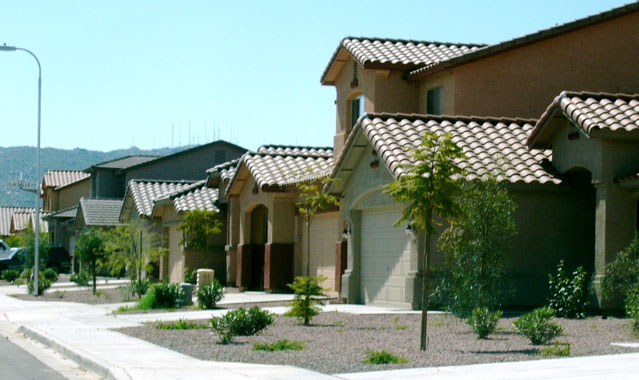|
|
|
| Chris Brown's Project Pages
|
Great Value, By Chris Brown The new home market in South Phoenix can only be described as sizzling. In fact, that is what a January 2005 article in the Arizona Republic written by Ginger Richardson asserts. Describing home values that “soar” and heavy “demand outstripping supply,” the article brings light to an interesting process taking place in one of Phoenix’s poorest and most unheralded neighborhoods. As cheap land close to the city becomes increasingly hard to find, suburbanites looking for a reasonable new home have begun looking to South Phoenix, an area historically ignored and politically isolated. While negative preconceptions have kept new housing out of the area for decades, rosy news articles and promotional material from home builders have done their best to make South Phoenix sound like the greatest place to buy a new home in Arizona; advertising a “great value, great floor plans, [and] great communities.” Vineyard Vista is a community being built on 19th Avenue north of Baseline by Great Western Homes. A visit to the model homes reveals that every home site available has been spoken for. Asking the salesman present about other home sites, he sounds untroubled; not bothering to give a sales pitch because he knows the lots will sell regardless of his actions. Two plots were expected to open for sale the next day, and the salesman assured me that they would sell within an hour.
Vineyard Vista is just one of dozens of communities being built in South Phoenix, all catering to young families and professionals looking for affordable housing that is not halfway to Flagstaff or Tucson. Historically, South Phoenix was not a hot spot for housing, despite its close proximity and low land prices. Bad press about gangs and poverty, along with a racial profile with a Hispanic majority and heavy black population, made middle-class Anglos shy away from the area. Today, there are few affordable options near downtown Phoenix available. The pros to living in the area have finally outweighed the cons, thanks to private development, news articles painting a rosy picture, and Phoenix’s concerted effort to “develop” South Phoenix. The February 2005 issue of South Mountain District News includes an article fitting the description above, speaking to the hot new home market, listing local attractions that bring in home buyers, and generally letting everyone know that South Phoenix is a great place to live. Reading the article, it is clear that many opportunities await new home buyers. The impact on the pre-existing communities, however, has been left out. Neil Smith, in “The New Urban Frontier: Gentrification and the Revanchist City,” is one person speaking about the displacement of socially and economically outclassed groups by those with power and money. As he states on the back cover of the book, “public policy and the private market are conspiring against minorities, working people, the poor, and homeless people as never before.” New language used in promotional material, the press, and media, according to Mr. Smith and supported by examples from modern South Phoenix, “implies that no one lives in the areas being pioneered – no one worthy of notice, at least.” (33) While a complete and specific exploration of the processes taking place in South Phoenix is not possible in this essay, it is important to introduce and leave for discussion the idea of how and why the powerful classes in America can “pioneer” areas that are already occupied. Newspapers, Phoenix planners, private developers, and new home propaganda have all been careful to sidestep any discussion of cultural or physical destruction of the often overlooked residents of South Phoenix. Of course, the future of the area is not yet set in stone. Nobody knows if the new development will be able to leave important cultural and historic business and housing intact, making a blend of the old and new that serves residents uniquely and wonderfully, or if the new building rage will overtake concerns for preservation and diversity. One thing is for certain however, without paying careful attention, the people of South Phoenix may be losing more than the empty lot next to their house; they may be losing their communities.
|

